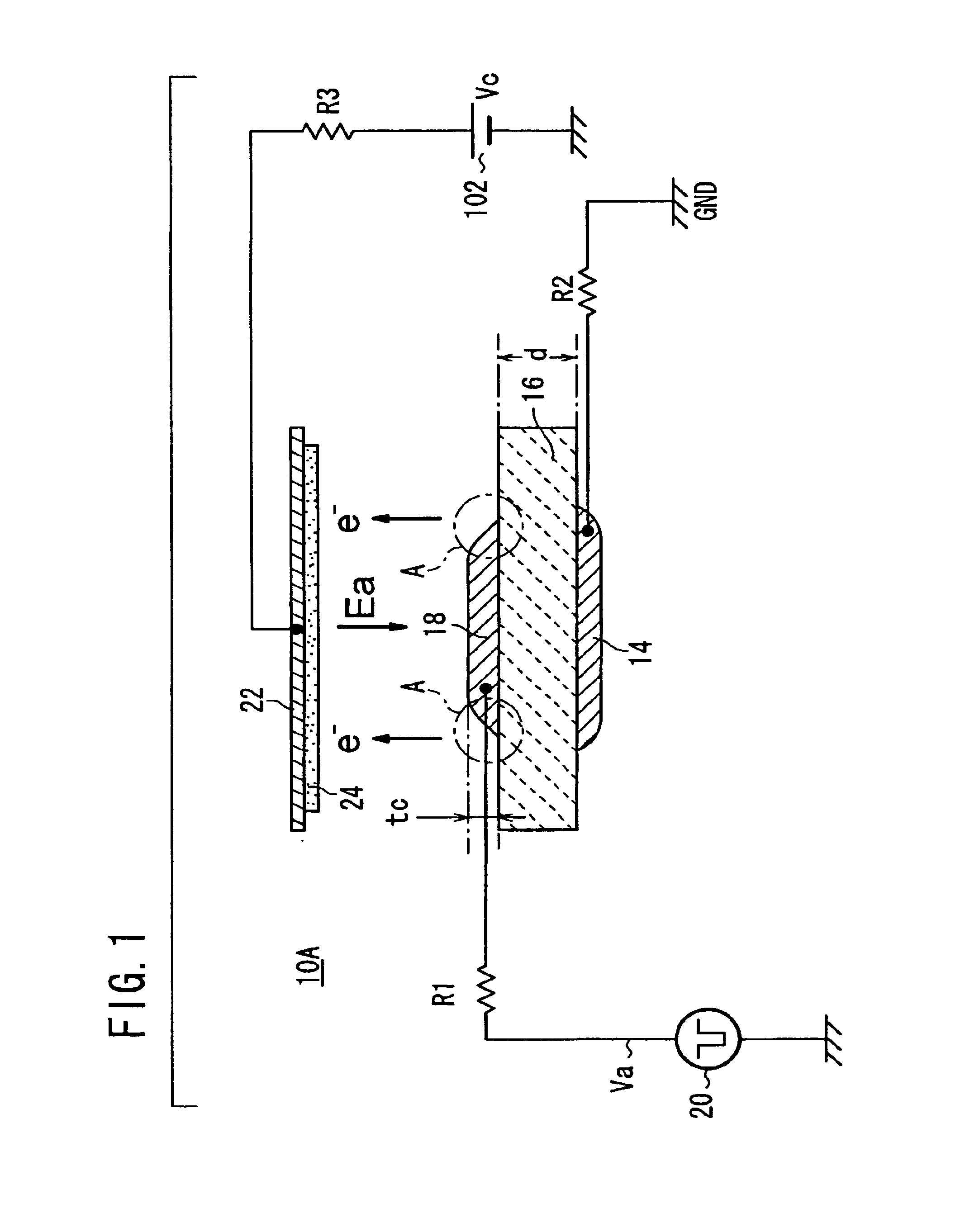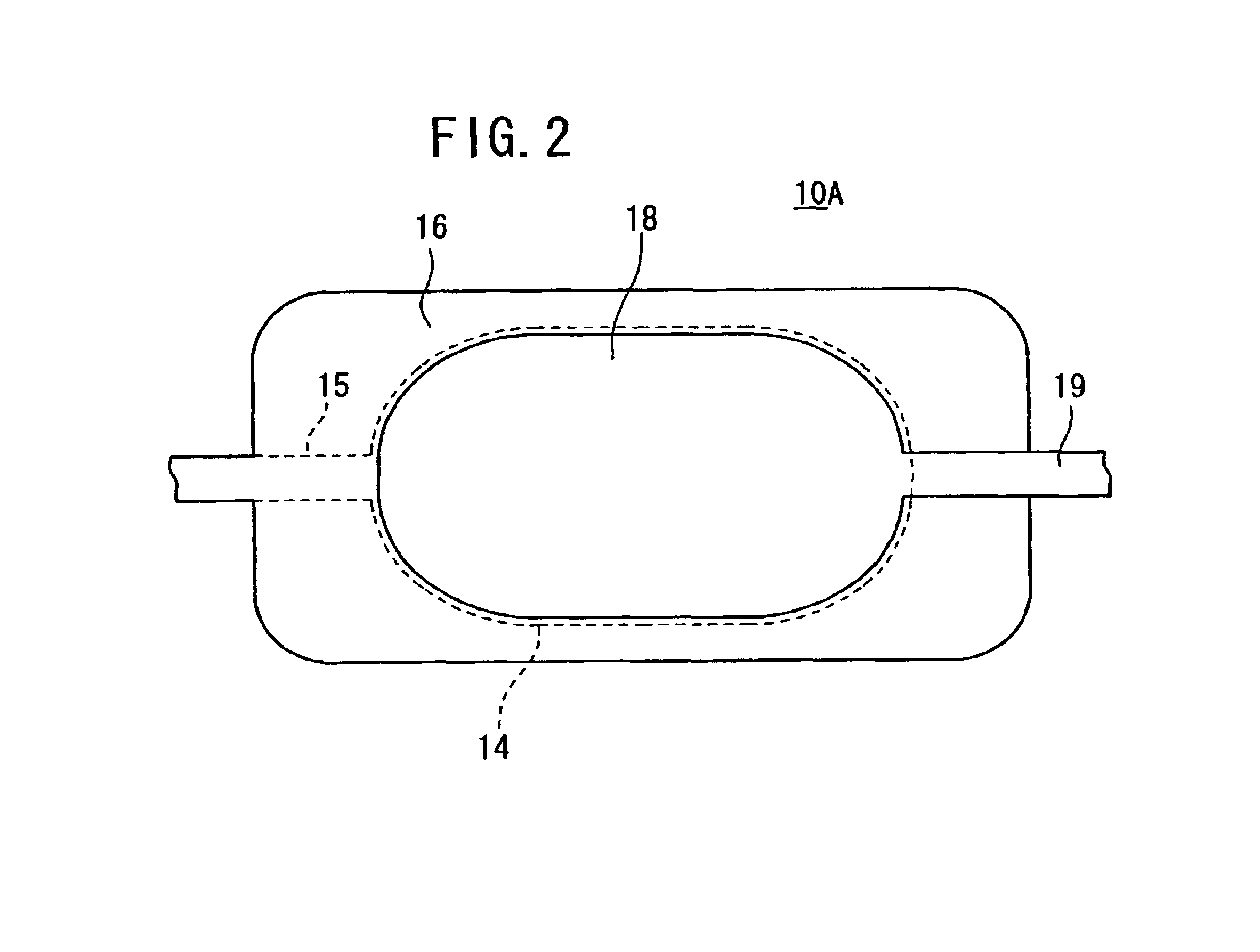Electron emitter comprising emitter section made of dielectric material
- Summary
- Abstract
- Description
- Claims
- Application Information
AI Technical Summary
Benefits of technology
Problems solved by technology
Method used
Image
Examples
first embodiment
[0061]As shown in FIG. 1, an electron emitter 10A has an emitter section 16 having a plate shape, a first electrode (cathode electrode 18) formed on a front surface of the emitter section 16, and a second electrode (anode electrode 14) formed on a back surface of the emitter section 16.
[0062]A drive voltage Va from a pulse generation source 20 is applied between the cathode electrode 18 and the anode electrode 14 through a resistor R1. In an example shown in FIG. 1, the anode electrode 14 is connected to GND (ground) and hence set to a zero potential. However, the anode electrode 14 may be set to a potential other than the zero potential. As shown in FIG. 2, the drive voltage Va is applied between the cathode electrode 18 and the anode electrode 14 through a lead electrode 19 extending from the cathode electrode 18 and a lead electrode 15 extending from the anode electrode 14, for example.
[0063]For using the electron emitter 10A as a pixel of a display, a collector electrode 22 is ...
second embodiment
[0111]FIG. 12 is a view showing an electron emitter 10B according to the present invention. The electron emitter 10B includes a protective film 30 formed on the emitter section 16 to cover the cathode electrode 18. The protective film 30 formed on the surface of the emitter section 16 prevent the emitter section 16 from being damaged due to the electrons emitted from the cathode electrode 18 toward the emitter section 16. Further, even if ionization occurs due to the electron emission, the protective film 30 reduces the damages of the cathode electrode 18 by the positive ions.
[0112]FIG. 13 is a view showing an electron emitter 10Ba of a first modification. The electron emitter 10Ba has a protective film 30 made of a conductor. The protective film 30 is likely to be eroded by the emitted electrons. The conductor should have a small sputtering yield (the number of target atoms or molecules per one incident ion). Preferably, the conductor has a sputtering yield of 2.0 or less at 600V i...
third embodiment
[0120]Next, an electron emitter 10C will be described with reference to FIG. 15.
[0121]As shown in FIG. 15, the electron emitter 10C according to the third embodiment has substantially the same structure as the electron emitter 10A according to the first embodiment, but differs from the electron emitter 10A in that the electron emitter 10C includes one substrate 12, an anode electrode 14 is formed on the substrate 12, the emitter section 16 is formed on the substrate 12 to cover the anode electrode 14, and the cathode electrode 18 is formed on the emitter section 16.
[0122]As with the electron emitter 10A according to the first embodiment, the electron emitter 10C can prevent damage to the cathode electrode 18 by the positive ions, and has a long service life.
[0123]The emitter section 16 may be formed on the substrate 12 by any of various thick-film forming processes including screen printing, dipping, coating, electrophoresis, etc., or any of various thin-film forming processes incl...
PUM
 Login to View More
Login to View More Abstract
Description
Claims
Application Information
 Login to View More
Login to View More - R&D
- Intellectual Property
- Life Sciences
- Materials
- Tech Scout
- Unparalleled Data Quality
- Higher Quality Content
- 60% Fewer Hallucinations
Browse by: Latest US Patents, China's latest patents, Technical Efficacy Thesaurus, Application Domain, Technology Topic, Popular Technical Reports.
© 2025 PatSnap. All rights reserved.Legal|Privacy policy|Modern Slavery Act Transparency Statement|Sitemap|About US| Contact US: help@patsnap.com



